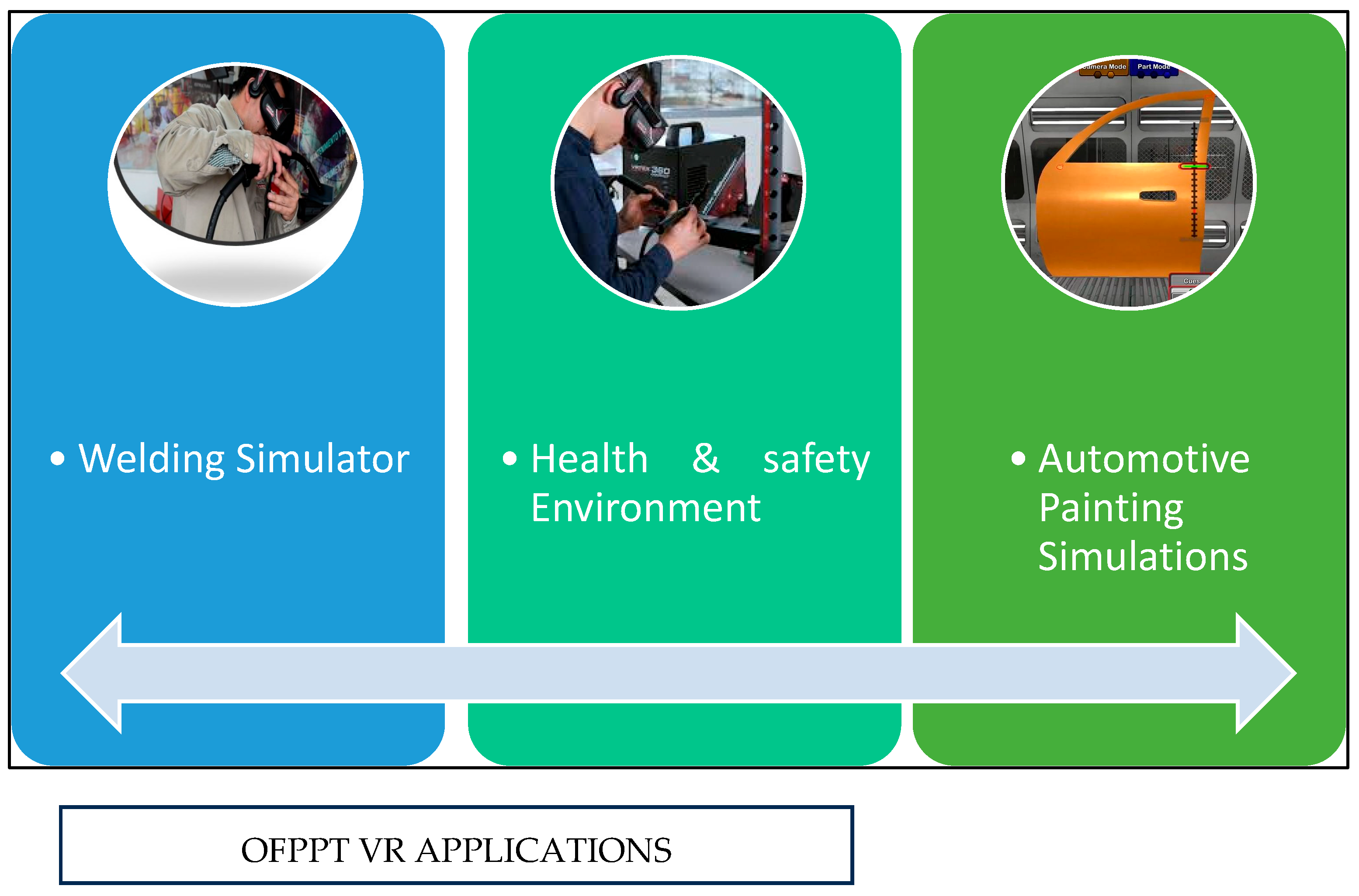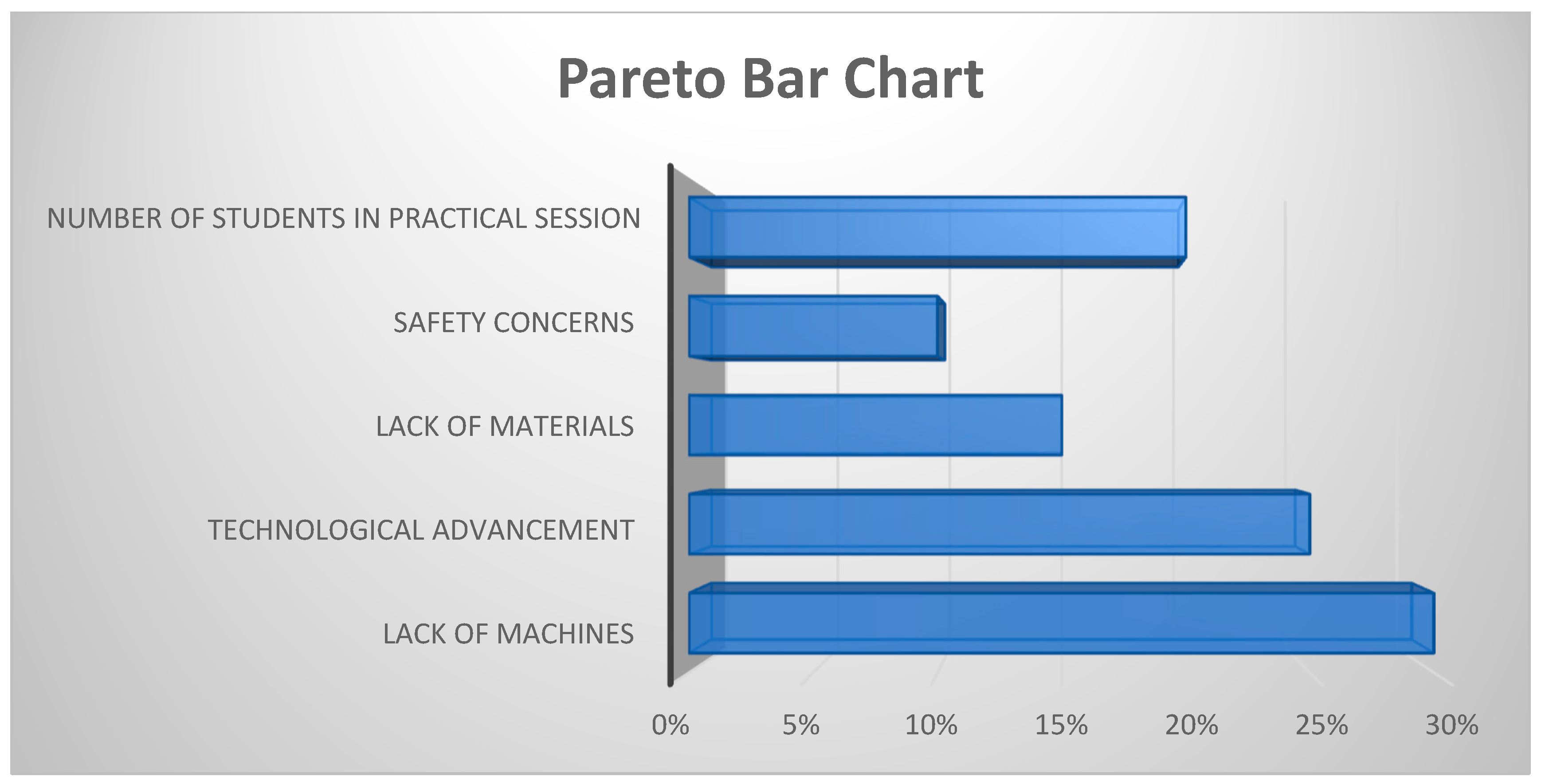Developing a Virtual Laboratory Framework Based on the Lean Approach in Engineering Education: A Response to Industry 4.0 Skills †
Abstract
1. Introduction
2. The Literature Review
2.1. Virtual Reality in Industry 4.0
2.2. Virtual Reality in Higher Education
2.3. Virtual Reality in Industry and Education: Highlights from Morocco
2.4. Illustrative Applications of Virtual Reality in the Educational Landscape of Morocco

3. Methodology
3.1. Defining the Problem: Assessing the Need for the Integration of VR into Moroccan Engineering Education Through Participant Observation
3.2. Prioritizing the Need for VR in Engineering Education: A Pareto Analysis of Participant Observation Data
4. The Conception of a Virtual Laboratory: From Concept to Implementation
4.1. The Conception of a Virtual Laboratory for Mechanical Engineering in the Moroccan Context
- ➢
- An In-Depth Look at Moroccan Mechanical Engineering Program Curricula
- ➢
- Using the APC to Extracting Key Practical Skills
- ➢
- Integrating Industry 4.0-Relevant Skills into the Curriculum
4.2. The Lean Approach to the Laboratory Implementation of Machines
4.3. Lean Tools and Techniques in Virtual Laboratory Design: Optimizing Its Conception
5. Results and Discussion
6. Conclusions
Author Contributions
Funding
Institutional Review Board Statement
Informed Consent Statement
Data Availability Statement
Acknowledgments
Conflicts of Interest
References
- Hermann, M.; Pentek, T.; Otto, B. Design Principles for Industrie 4.0 Scenarios. In Proceedings of the 2016 49th Hawaii International Conference on System Sciences (HICSS), Koloa, HI, USA, 5–8 January 2016; pp. 3928–3937. [Google Scholar]
- Liao, Y.; Deschamps, F.; Loures, E.d.F.R.; Ramos, L.F.P. Past, Present and Future of Industry 4.0—A Systematic Literature Review and Research Agenda Proposal. Int. J. Prod. Res. 2017, 55, 3609–3629. [Google Scholar] [CrossRef]
- Nounou, A.; Jaber, H.; Aydin, R. A Cyber-Physical System Architecture Based on Lean Principles for Managing Industry 4.0 Setups. Int. J. Comput. Integr. Manuf. 2022, 35, 890–908. [Google Scholar] [CrossRef]
- Elmqaddem, N. Augmented Reality and Virtual Reality in Education. Myth or Reality? Int. J. Emerg. Technol. Learn. 2019, 14, 234. [Google Scholar] [CrossRef]
- Talbi, K.; Zergout, I.; Souad, A. ZinebAithaddouchane Analytical Study of Virtual Reality in Moroccan Higher Education. In Proceedings of the 2023 7th IEEE Congress on Information Science and Technology (CiSt), Essaouira, Morocco, 16–22 December 2023; pp. 503–507. [Google Scholar]
- Liyuan, L. The Application of Virtual Reality and Augmented Reality Technology in the Field of Education. J. Phys. Conf. Ser. 2020, 1684, 012109. [Google Scholar] [CrossRef]
- Thakur, T.; Bhatia, S.; Kaur, G.; Thakur, T.; Bhatia, S.; Kaur, G. Influence of Virtual Reality as a Tool to Revolutionize Industry Education. Available online: https://www.igi-global.com/gateway/chapter/www.igi-global.com/gateway/chapter/349422 (accessed on 13 February 2025).
- Akpan, I.J.; Offodile, O.F. The Role of Virtual Reality Simulation in Manufacturing in Industry 4.0. Systems 2024, 12, 26. [Google Scholar] [CrossRef]
- Keswani, B.; Mohapatra, A.G.; Mishra, T.C.; Keswani, P.; Mohapatra, P.C.G.; Akhtar, M.M.; Vijay, P. World of Virtual Reality (VR) in Healthcare. In Advanced Computational Intelligence Techniques for Virtual Reality in Healthcare; Gupta, D., Hassanien, A.E., Khanna, A., Eds.; Springer International Publishing: Cham, Switzerland, 2020; pp. 1–23. ISBN 978-3-030-35252-3. [Google Scholar]
- Johansson, M.; Roupé, M. Real-World Applications of BIM and Immersive VR in Construction. Autom. Constr. 2024, 158, 105233. [Google Scholar] [CrossRef]
- Zhang, Y.; Shao, W.; Quach, S.; Thaichon, P.; Li, Q. Examining the Moderating Effects of Shopping Orientation, Product Knowledge and Involvement on the Effectiveness of Virtual Reality (VR) Retail Environment. J. Retail. Consum. Serv. 2024, 78, 103713. [Google Scholar] [CrossRef]
- Turner, C.J.; Hutabarat, W.; Oyekan, J.; Tiwari, A. Discrete Event Simulation and Virtual Reality Use in Industry: New Opportunities and Future Trends. IEEE Trans. Hum.-Mach. Syst. 2016, 46, 882–894. [Google Scholar] [CrossRef]
- Effectiveness of Immersive VR in STEM Education | IEEE Conference Publication | IEEE Xplore. Available online: https://ieeexplore.ieee.org/abstract/document/9320779 (accessed on 13 February 2025).
- Hsieh, M.C.; Lee, J.J. Preliminary Study of VR and AR Applications in Medical and Healthcare Education. J. Nurs. Health Stud. 2018, 3, 100030. [Google Scholar] [CrossRef]
- Publié le 24 Juillet 2022 par Brahim Habriche. Available online: https://www.lavieeco.com/affaires/carriere/limmersive-learning-fait-son-chemin/ (accessed on 24 July 2022).
- Available online: https://www.enssup.gov.ma/en/actualites/lancement-des-seances-d-ecoute-et-de-consultation-pour-la-co-construction-du-plan-national-d-acceleration-de-la-transformation-de-l-ecosysteme-de-l-enseignement-superieur-de-la-recherche-scientifique-et-de-l-innovation (accessed on 16 February 2022).
- Available online: https://www.mmsp.gov.ma/fr/actualites/la-vision-%C3%A9clair%C3%A9e-de-sa-majest%C3%A9-le-roi-mohammed-vi-que-dieu-le-glorifie-plac%C3%A9-le-num%C3%A9rique-au-centre-des-priorit%C3%A9s-nationales (accessed on 5 September 2024).
- Talbi, K.; Aithaddouchane, Z.; Zergout, I.; Ajana, S. Virtual Reality in Moroccan Higher Education: Swot Analysis. Int. J. Inf. Sci. Technol. 2024, 8, 26–35. [Google Scholar] [CrossRef]
- Handbook of Qualitative Research—ProQuest. Available online: https://www.proquest.com/openview/5d9ea365c771fc82a1945ef79e7cd533/1?pq-origsite=gscholar&cbl=1816610 (accessed on 14 February 2025).
- Pareto Diagrams Get to the Root of Process Problems—ProQuest. Available online: https://www.proquest.com/openview/61594e91f7a64c8abd547df03b6de8fd/1?pq-origsite=gscholar&cbl=35812 (accessed on 14 February 2025).
- Haddouchane, Z.A.; Faraj, K.; Bakkali, S.; Ajana, S. Etude Critique Des Référentiels de Compétences Du Génie Mécanique. J. Qual. Educ. 2017, 6, 12. [Google Scholar] [CrossRef]
- Eppes, T.A.; Milanovic, I.; Jamshidi, R.; Shetty, D. Engineering Curriculum in Support of Industry 4.0. Int. J. Online Biomed. Eng. (iJOE) 2021, 17, 4–16. [Google Scholar] [CrossRef]
- Laad, M.; Renedo, M. Skill Requirement in Industry 4.0. In Industry 4.0 in Small and Medium-Sized Enterprises (SMEs); Laad, M., Renedo, M., Eds.; CRC Press: Boca Raton, FL, USA, 2022; ISBN 978-1-00-320085-7. [Google Scholar]
- Sundar, R.; Balaji, A.N.; Kumar, R.M.S. A Review on Lean Manufacturing Implementation Techniques. Procedia Eng. 2014, 97, 1875–1885. [Google Scholar] [CrossRef]
- Gupta, S.; Jain, S.K. A Literature Review of Lean Manufacturing. Int. J. Manag. Sci. Eng. Manag. 2013, 8, 241–249. [Google Scholar] [CrossRef]
- Hadek, A.; Bakkali, S.; Ajana, S. Evaluation of the Lean Approach Implementation in Engineering Education. Emerg. Sci. J. 2023, 7, 1126–1137. [Google Scholar] [CrossRef]
- Hawkins, I.; Phelps, A.J. Virtual Laboratory vs. Traditional Laboratory: Which Is More Effective for Teaching Electrochemistry? Chem. Educ. Res. Pract. 2013, 14, 516–523. [Google Scholar] [CrossRef]


Disclaimer/Publisher’s Note: The statements, opinions and data contained in all publications are solely those of the individual author(s) and contributor(s) and not of MDPI and/or the editor(s). MDPI and/or the editor(s) disclaim responsibility for any injury to people or property resulting from any ideas, methods, instructions or products referred to in the content. |
© 2025 by the authors. Licensee MDPI, Basel, Switzerland. This article is an open access article distributed under the terms and conditions of the Creative Commons Attribution (CC BY) license (https://creativecommons.org/licenses/by/4.0/).
Share and Cite
Talbi, K.; Haddouchane, Z.A.; Bakkali, S.; Ajana, S. Developing a Virtual Laboratory Framework Based on the Lean Approach in Engineering Education: A Response to Industry 4.0 Skills. Eng. Proc. 2025, 97, 13. https://doi.org/10.3390/engproc2025097013
Talbi K, Haddouchane ZA, Bakkali S, Ajana S. Developing a Virtual Laboratory Framework Based on the Lean Approach in Engineering Education: A Response to Industry 4.0 Skills. Engineering Proceedings. 2025; 97(1):13. https://doi.org/10.3390/engproc2025097013
Chicago/Turabian StyleTalbi, Khadija, Zineb Ait Haddouchane, Soumia Bakkali, and Souad Ajana. 2025. "Developing a Virtual Laboratory Framework Based on the Lean Approach in Engineering Education: A Response to Industry 4.0 Skills" Engineering Proceedings 97, no. 1: 13. https://doi.org/10.3390/engproc2025097013
APA StyleTalbi, K., Haddouchane, Z. A., Bakkali, S., & Ajana, S. (2025). Developing a Virtual Laboratory Framework Based on the Lean Approach in Engineering Education: A Response to Industry 4.0 Skills. Engineering Proceedings, 97(1), 13. https://doi.org/10.3390/engproc2025097013




